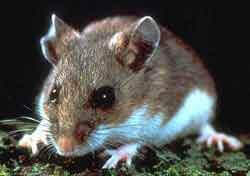Field Mouse Control: Protect Your Home or Business
Facts
- The term field mouse can describe several species found throughout the Mid-Atlantic states, including the deer mouse and white-footed mouse.
- These pests eat fruit and seeds, but they’ll also eat plants as well as insects on occasion.
- Depending on the species, female field mice can give birth to approximately 30 pups per year.
Appearance

Adult field mice can be anywhere from six to eight inches in length from nose to tail tip. The fur on their backs is brownish-gray, while their underbellies and feet are pure white. Their large dark eyes help them see better in the dark.
How Do Field Mice Get Inside Buildings?
These mice sometimes invade homes and businesses. Their agile bodies allow them to squeeze through broken vents and foundation cracks easily. Once inside, the rodents nest in secluded corners, attics, crawl spaces, and basements.
These pests will also enter buildings when meals are scarce. Elementary schools, restaurants, and food processing plants are prime locations for field mice to find scraps. They’ll often scavenge floors, cabinets, and countertops for fallen crumbs and other leftovers.
Signs of Field Mouse Infestation
- Droppings – Field mice feces are about the size and shape of a grain of rice. You may notice mouse waste on floors, near baseboards, under sinks, or in basements and attics.
- Noises – Young field mice use high-pitched squeaks to communicate. If you hear these sounds, there may be a nest nearby.
- Hoarding – These rodents create food caches in hard-to-reach places away from people and other pests. Discovering hidden piles of nuts, seeds, or grains may indicate a field mouse infestation.
Problems Caused by Field Mice
Though they’re small, these rodents can cause major issues, as these rodents are vectors for hantavirus. Inhaling airborne particles after stirring up dry deer or white-footed mouse waste with a broom or cloth is a common means of infection. Additionally, the pests host ticks that transmit Lyme disease.
This species of mice can also cause structural problems when indoors. They gnaw on exposed wires, scratch wooden fixtures as well as walls, and tear up insulation while gathering nesting materials. This behavior often leads to costly damages for both home and business owners.
Prevention Tips
Repair any outside cracks, gaps, or holes that could allow field mice into your home or office. Good sanitation practices in kitchens, cafeterias, warehouses, and schools eliminate crumbs and spills that attract rodents. Nuts, fallen fruit, and birdseed invite them into yards, too. If you believe you have a field mouse issue, contact the experts at Western Pest Services.